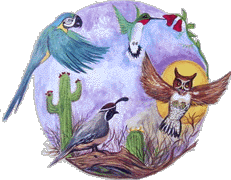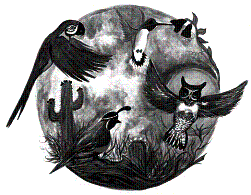|
Little
'Jack' Sparrow Has a Chance
By Bette and Ed Sharpe Glendale Daily Planet
Oh No! Honey... the cat has
a bird....
Wednesday evening or cat Rudy
brought us a present, a baby bird. With
several tissues, I carefully placed him in a shoebox, with holes for air,
before he suffered anymore trauma. I
noticed a small red dot of blood on the tissue, which to me indicated a
small wound of some kind.
With an old syringe that was
leftover from some dental work of Ed's, we gave the little bird some sugar
water. The little bird drank
some and moved around a little. Thank goodness! We
lined the shoebox with newsprint, added a washcloth, placed the baby bird
in the hospital-box, and sequestered the box with the lid slightly ajar on
a shelf in the closet. We
closed the closet door. No
cats allowed in here!
We called him Birdie at first,
but we were quickly getting attached to him, so we gave him a real name,
Jack. Good night Jack Sparrow!
The
Solve!
The the next morning we checked
on Jack. He make it through
the night!
Ed and I knew the bird needed
more help than we could give him. So
after calling a few veterinary clinics, it was recommended for us to
contact Fallen Feathers. I
called them, and we could bring our bird to them for some help.
We got Jack and we were on our way.
Jack was getting weaker, he
only had a little nourishment from the sugar-water over the last twelve
hours, and then... there was that wound.
We met with Jody Kieran, the
confident, passionate woman behind Fallen Feathers, a rescue educational
and adoption service for birds.
She has been taking care of
birds for fifteen years. Jack
Sparrow was given some antibiotics to fend off any possible bacteria from
the nick the cat gave him. Jack
was presented with some
solid food to ease the taste of the medicine.
Interestingly enough, with the first bit of food, Jack got some of
his energy back.

Jody Kieran, the confident,
passionate woman
behind the rescue, educational, and adoption
services at 'Fallen Feathers' |

Much can be told about the
bird's health by
the color and texture of the feathers. |
During
our short visit, two other birds were brought to Jody for help.
All three of us had the same feeling; we wanted to do something for
them. The best thing each of
us did was to bring our birds to Jody at Fallen Feathers.
She knows what to do. Hers
is the only bird care center on the west side of the valley.
A
busy facility, it is evident the passion and love Jody and her volunteers
have for our feathered friends!
Jody
told us: "This is busy baby bird time in Arizona.
In fact, Arizona has the longest baby bird season than any other
state."

'Jack' Sparrow
was given some antibiotics
to fend off possible bacteria from the
nick the cat had given it.
An added note at this point
although we gave the bird water and keep it hydrated, this is
not always the best plan. Read the instructions that Jody provides
on her website for care and feeding of you new
found friend. Since bird's airway is at the back of the throat
behind their tongue, it
is easy to down them when administering liquids incorrectly. Again
- read http://www.fallenfeathers.org
An
'Equal Opportunity' Care Facility
If you find a lost or injured
bird, even a pigeon or a sparrow, Fallen Feathers might be able to help.
They offer help to all birds that are lost orphaned on injured,
including helping with the bird's capture when intervention is needed.
Not all shelters will accept pigeons and sparrows and Veterinarians
often do not have the specialized training to help injured birds.
Fallen Feathers aim is to return
birds back to their parents or back into the wild, which ever is best for
the bird. Sometimes the bird's parents are not available, as was the
case with our sparrow. The
young bird has to be cared for until it can survive on its own.
At Fallen Feathers, a licensed bird-rehabilitator or a veterinarian
provides medical attention, if needed.
The baby sparrow we brought in was given antibiotics and some food
by Jody and responded to both the food and drink.
This just made our day.
Educational presentations are
provided upon request and are based on availability.
Some of the exotic birds at Fallen Feathers can be adopted.
Most importantly, there is a strict process to ensure that the bird
and its new family are good match. You
cannot just walk in a pick out bird and go home.
That's just how some of the feathered guys came to be at Jody's in
the first place.
Finding a new family friend
The adoption starts out with
you visiting the Fallen Feathers facility, do some volunteer
work and play with the birds.
If
a bird takes a liking to you, the next step is you are allowed to take
it home for a sleepover. The next day the bird is
returned to the facility where things are discussed to make
sure that there is a good match.. if not, you get to try
another bird.
Eventually after a few other
extended sleepover sessions, you and Jody will know if you have the
right bird match and you now will have a new family member!
Little Jack is doing better,
thanks to Jody at Fallen Feathers. The
cost of all of this for Ed and I was a bunch of worry, some time, and a
little gas (and we slipped some $$$ into the donation box!)
A happy ending!
Checking back later that
week, Jack Sparrow was doing well and running around with 7
other tiny baby sparrows at Fallen Feathers!

Jack Sparrow and three friends! Jack is on the left in front of another
bird
(that is why he looks a little large!) - Photo By Jody
Kieran Fallen Feathers
For more
information
 Website:
http://www.fallenfeathers.org Website:
http://www.fallenfeathers.org
Address: Fallen Feathers, 9532 W. Cielo
Grande, Peoria AZ 85383
NOTE: Be sure to print
out the map and directions - they are wonderful!
If you would like to donate
some of these items, you can help. There
have been 525 species of birds spotted in Arizona.
Money is always welcomed. The
services Jody provided today for us were at no cost, we were very
grateful.
The following list of donations is welcomed
as well as your time, talent and your dollars.
|
Please donate
some of these items - You can help! |
|
tool chest
cleaning
supplies
office
supplies
power tools
RV or van
heatlamps/heating
pads
carriers/keels/aviaries
paper towels
|
tool cages
land
ceramic pet
dishes
puppy &
kitten chow
gift cards to
pet stores
lumber (2x4,
4x4, 2x6)
plywood sheets
3/4 electrical
conduit pipe
|
hardware
(nails, screws, etc.)
trash bags
ziplock bags
dry baby
cereal
seed, fruit,
nuts
glass ash tray
shade cloth
& sails/camouflage netting
gift cards for
building supplies
|
Temporary
Emergency Care of Wild Birds
1.
KEEP THE BIRD WARM
The first and most important
thing to do when you find an orphaned or injured bird is to warm the bird
to a normal temperature. The
bird must be warmed before it can be fed!
Place paper towels or rags in
the bottom of a box, small cage or other container. Place the bird inside. You may need to use crumpled paper towels to prop up
the bird if it is weak so that it is in a safe position.
Place the container on a heating
pad set on low. If your heating pad has auto-shutoff, be sure to check it to
make sure it is still on. If
you do not have a heating pad be sure to keep the bird in the warmest
place available, but donít overheat the bird.
2.
NEVER PUT WATER IN A BIRDS MOUTH!
A birdís airway is located on
the bottom of their mouths behind their tongue.
Because of the location of the airway it is not uncommon for the
water to go into the birdís airway then to their lungs; if this happens,
they could die from aspiration.
3.
FEEDING THE BIRD -- DO NOT FEED THE BIRD IF IT IS A
HUMMINGBIRD OR A RAPTOR, OR IF THE BIRD IS LETHARGIC!
After the bird is warmed, you
may want to give a small amount of food.
Prepare as listed.
BABY
BIRDS:
Take any dry cat or dog food,
place it in lukewarm water and wait for it to turn soft.
Once the food is softened, take small pieces of the food and
squeeze the water out of it so that it is moist but not dripping. You can then place the food in the back center birdís
mouth; this will give the bird moisture and protein at the same time but
avoids the chances of aspiration. The
baby bird will need to be fed every 15 to 20 minutes.
ADULT
BIRDS:
Because of the various diets
that each particular bird eats it is best to offer a small variety of
foods. Seed, fresh fruit and
water-moistened dog food can be placed before the bird; allow them to
choose which most appeals to them.
4.
CALL US!
(623) 533-2348
 Fallen
Feathers Fallen
Feathers
Rescue,
Rehabilitation & Education
9532
W. Cielo Grande
Peoria,
AZ 85383
www.fallenfeathers.org

|

